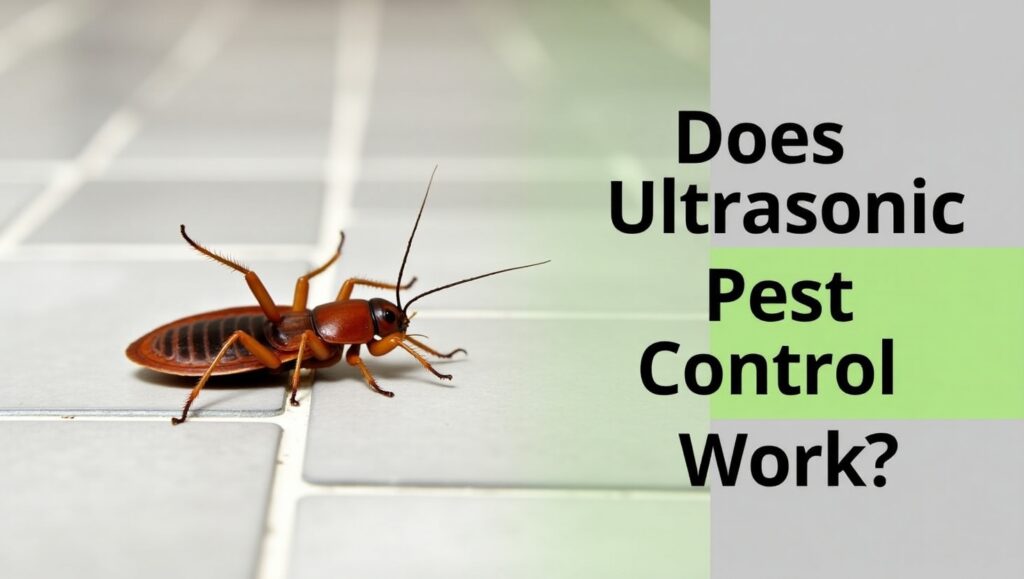Ultrasonic pest control devices have gained popularity as a modern, eco-friendly alternative to traditional pest control methods. Marketed as safe, chemical-free, and easy to use, these devices promise to repel pests using nothing more than high-frequency sound waves. But does ultrasonic pest control work as advertised, or is it just a clever gimmick?
In this article, we’ll break down how these devices function, what pests they claim to deter, and whether scientific evidence supports their effectiveness. We’ll also cover the pros and cons, safety considerations, and when it’s time to call in the professionals.
What Is Ultrasonic Pest Control?
Ultrasonic pest control involves the use of electronic devices that emit sound waves at frequencies between 20 kHz and 65 kHz. These high-frequency sound waves are generally inaudible to humans but are designed to disrupt the auditory and nervous systems of common household pests.
Manufacturers of ultrasonic repellers claim they can deter a wide variety of pests, including:
-
Rodents (rats and mice)
-
Insects (ants, cockroaches, mosquitoes, flies)
-
Spiders
-
Sometimes even termites (though this is hotly debated)
These devices are usually plug-in units designed for indoor use, though some portable, battery-powered models are available.
How Do Ultrasonic Pest Repellers Work?
Ultrasonic pest repellers work by emitting high-frequency sound waves that disturb pests’ normal behavior. The theory is that the sound:
-
Interferes with their communication
-
Irritates or disorients their nervous systems
-
Makes the environment uncomfortable, encouraging them to leave
Because these frequencies are above the range of human hearing, the devices are silent to us. They’re typically plugged into wall outlets in kitchens, basements, or attics—places where pests are likely to enter or nest.
However, ultrasonic waves do not travel well through walls, furniture, or soft materials, which limits their effective range and penetration.
The Popularity of Ultrasonic Pest Devices
So, why have ultrasonic pest devices become so widespread?
Key Reasons:
-
Chemical-free: No toxins or pesticides involved.
-
Safe for kids and pets: Appealing to families and pet owners.
-
Ease of use: Just plug them in and forget.
-
Low cost: Typically under $30 per unit.
You can find them in online marketplaces, hardware stores, supermarkets, and even convenience stores. They’re often promoted with bold claims like “covers 5,000 sq. ft.” or “repels all types of pests.”
But do these marketing claims hold up under scrutiny?
Do Ultrasonic Pest Repellers Actually Work?
This is the big question—and the answer is not so straightforward.
🔬 Scientific Evidence
Multiple scientific studies have investigated ultrasonic pest repellers. The results are mixed:
-
Some lab studies show short-term repelling effects on certain pests like mice or insects.
-
Other studies found no significant effect, especially in real-world, furnished environments.
🔍 Why Results Vary:
-
Pest Species: Different pests respond differently to ultrasound. Mice might be sensitive to it; cockroaches might not care.
-
Room Layout: Furniture, curtains, and walls block sound waves.
-
Habituation: Pests may initially leave, but many get used to the sound over time.
-
Power and Range: Many devices are not powerful enough to cover an entire room, let alone a house.
In summary, ultrasonic pest control may help in limited, controlled environments, but it’s not a guaranteed or lasting solution, especially for large infestations.
6. Pros and Cons of Ultrasonic Pest Control
✅ Pros:
-
Easy to use: Plug in and forget.
-
No chemicals or mess: Great for sensitive households.
-
Affordable: Lower upfront cost than professional services.
-
Silent operation: No noise pollution for humans.
❌ Cons:
-
Inconsistent effectiveness: Results vary based on pests and environment.
-
Limited range: Can’t pass through walls or solid objects.
-
Not a cure-all: May repel but won’t kill or eliminate infestations.
-
Temporary effects: Pests can adapt or return over time.
What Pests Do Ultrasonic Repellers Claim to Control?
Ultrasonic devices commonly claim to repel:
-
Rodents: Mice and rats are among the primary targets.
-
Cockroaches: Some users report fewer sightings, but evidence is weak.
-
Ants: Mixed results—depends on the species.
-
Mosquitoes and flies: Often ineffective; better methods exist.
-
Spiders: Little scientific support for this claim.
-
Termites: Highly questionable; professional treatment is recommended.
Overall, claims often outpace scientific support, especially for insects like termites or ants.
Are Ultrasonic Pest Repellers Safe for Humans and Pets?
One of the biggest selling points of these devices is their safety.
-
Humans: Since ultrasonic frequencies are above 20 kHz, most adults can’t hear them.
-
Dogs and Cats: Typically not affected, although some may react initially.
-
Small Pets: Exercise caution with pets like hamsters, guinea pigs, rabbits, or ferrets, as their hearing ranges may overlap with ultrasonic frequencies.
✅ Conclusion on Safety:
Ultrasonic repellers are generally safe, but it’s wise to monitor small or exotic pets for signs of distress.
Alternatives to Ultrasonic Pest Control
If you find ultrasonic devices ineffective, consider these alternatives:
🔧 Professional Pest Control Services
-
Guaranteed results
-
Tailored treatment for specific pests
-
Effective for infestations
🪤 Traps, Baits, and Sprays
-
Use mechanical or chemical means to capture or kill pests
-
Can be very effective when placed correctly
🌿 Integrated Pest Management (IPM)
-
Combines prevention, monitoring, and control
-
Eco-friendly and sustainable
-
Focuses on long-term prevention
🧴 Natural and DIY Methods
-
Essential oils (peppermint, citronella)
-
Vinegar sprays
-
Sealing entry points
These options, while sometimes requiring more effort, usually offer better long-term results than ultrasonic-only solutions.
When Should You Call a Professional?
Ultrasonic devices might help with occasional intruders, but you should call a pest control expert if:
-
You see pests regularly despite using repellers
-
There’s evidence of nesting or damage
-
You notice droppings, chew marks, or foul odors
-
You’re dealing with termites, roaches, or rodents in large numbers
Professionals can accurately assess the situation and apply the most effective treatment safely.
Conclusion
So, does ultrasonic pest control work? The short answer is: sometimes, but not reliably.
These devices might deter certain pests in ideal conditions, but they’re not a substitute for proven pest control methods. For minor issues, they may offer a low-effort solution—but for anything more serious, they should be used alongside other strategies.
💡 Final Recommendation:
If you decide to try ultrasonic pest repellers, set realistic expectations. Use them in combination with proper sanitation, sealing entry points, and—when necessary—calling a professional for lasting results.
FAQs
Does ultrasonic pest control really work?
Sometimes. It may deter some pests short-term, but effectiveness is inconsistent and not guaranteed.
What pests do ultrasonic devices repel?
Manufacturers claim they repel rodents, cockroaches, ants, mosquitoes, spiders, and even termites—though success varies widely.
Are ultrasonic pest repellers safe for pets?
Yes, for most dogs and cats. Use caution with small pets like rabbits, hamsters, and guinea pigs.
Can ultrasonic pest repellers go through walls?
No. Ultrasonic waves are blocked by walls, furniture, and other obstacles, limiting their effectiveness.
How long does it take for ultrasonic pest control to work?
Some users report effects within a few days, but scientific evidence is lacking, and pests may return.
Do ultrasonic devices work on bed bugs?
No. There is no scientific evidence that ultrasound affects bed bugs.
Are ultrasonic pest control devices worth buying?
Depends. They’re affordable and easy to try, but results are hit-or-miss. Best used as a supplemental method.
What is the best alternative to ultrasonic pest control?
Integrated Pest Management (IPM) or professional pest control services offer the most reliable results.







